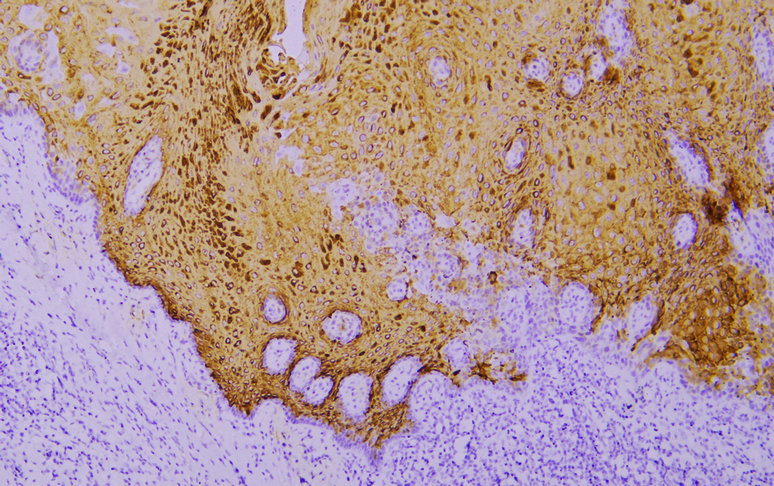Cytokeratin 13 (CK13) (ABT160R) rabbit mAb
- Catalog No.:YM7256
- Applications:IHC;WB; ELISA
- Reactivity:Human;
- Target:
- Cytokeratin 13
- Fields:
- >>Estrogen signaling pathway;>>Staphylococcus aureus infection
- Gene Name:
- KRT13
- Protein Name:
- 47 kDa cytokeratin;CK-13;CK13;Cytokeratin 13;Cytokeratin-13;K13;K1C13_HUMAN;Ka13;Keratin 13;Keratin;keratin type I cytoskeletal 13;Keratin-13;Krt-1.13;Krt1-13;KRT13;MGC161462;MGC3781;type I cytoskelet
- Human Swiss Prot No:
- P13646
- Mouse Swiss Prot No:
- P08730
- Rat Swiss Prot No:
- Q6IFV4
- Immunogen:
- Synthesized peptide derived from human Cytokeratin 13 AA range:400-458
- Specificity:
- This antibody detects endogenous levels of Cytokeratin 13
- Formulation:
- PBS, 50% glycerol, 0.05% Proclin 300, 0.05%BSA
- Source:
- Monoclonal, Rabbit IgG1, Kappa
- Dilution:
- IHC 1:100-500, WB 1:500-1000, ELISA 1:5000-20000
- Purification:
- Recombinant Expression and Affinity purified
- Storage Stability:
- -15°C to -25°C/1 year(Do not lower than -25°C)
- Other Name:
- 47 kDa cytokeRatin;CK-13;CK13;Cytokeratin 13;CytokeRatin-13;K13;K1C13_HUMAN;Ka13;KeRatin 13;KeRatin;keRatin type I cytoskeletal 13;KeRatin-13;Krt-1.13;Krt1-13;KRT13;MGC161462;MGC3781;type I cytoskeletal 13;Type I keRatin Ka13;WSN2
- Molecular Weight(Da):
- 50kD
- Background:
- The protein encoded by this gene is a member of the keratin gene family. The keratins are intermediate filament proteins responsible for the structural integrity of epithelial cells and are subdivided into cytokeratins and hair keratins. Most of the type I cytokeratins consist of acidic proteins which are arranged in pairs of heterotypic keratin chains. This type I cytokeratin is paired with keratin 4 and expressed in the suprabasal layers of non-cornified stratified epithelia. Mutations in this gene and keratin 4 have been associated with the autosomal dominant disorder White Sponge Nevus. The type I cytokeratins are clustered in a region of chromosome 17q21.2. Alternative splicing of this gene results in multiple transcript variants; however, not all variants have been described. [provided by RefSeq, Jul 2008],
- Function:
- disease:Defects in KRT13 are a cause of white sponge nevus of cannon (WSN) [MIM:193900]. WSN is a rare autosomal dominant disorder which predominantly affects non-cornified stratified squamous epithelia. Clinically, it is characterized by the presence of soft, white, and spongy plaques in the oral mucosa. The characteristic histopathologic features are epithelial thickening, parakeratosis, and vacuolization of the suprabasal layer of oral epithelial keratinocytes. Less frequently the mucous membranes of the nose, esophagus, genitalia and rectum are involved.,miscellaneous:There are two types of cytoskeletal and microfibrillar keratin: I (acidic; 40-55 kDa) and II (neutral to basic; 56-70 kDa).,online information:Keratin-13 entry,PTM:O-glycosylated; glycans consist of single N-acetylglucosamine residues.,similarity:Belongs to the intermediate filament family.,subunit:Heterotetramer of two
- Subcellular Location:
- Cytoplasmic, Membranous
- Expression:
- Tonsil
- June 19-2018
- WESTERN IMMUNOBLOTTING PROTOCOL
- June 19-2018
- IMMUNOHISTOCHEMISTRY-PARAFFIN PROTOCOL
- June 19-2018
- IMMUNOFLUORESCENCE PROTOCOL
- September 08-2020
- FLOW-CYTOMEYRT-PROTOCOL
- May 20-2022
- Cell-Based ELISA│解您多样本WB检测之困扰
- July 13-2018
- CELL-BASED-ELISA-PROTOCOL-FOR-ACETYL-PROTEIN
- July 13-2018
- CELL-BASED-ELISA-PROTOCOL-FOR-PHOSPHO-PROTEIN
- July 13-2018
- Antibody-FAQs
- Products Images

- Immunohistochemical analysis of paraffin-embedded human Laryngeal squamous cell carcinomas. 1, Antibody was incubated at 4° overnight. 2, Citrate buffer of pH6.0 was used for antigen retrieval. 3,Secondary antibody was diluted at 1:200(room temperature, 30min).

- Immunohistochemical analysis of paraffin-embedded human Oral squamous cell carcinoma. 1, Antibody was incubated at 4° overnight. 2, Citrate buffer of pH6.0 was used for antigen retrieval. 3,Secondary antibody was diluted at 1:200(room temperature, 30min).



